After the presentation on the electric aircraft, I headed out to see a bunch of the show (solo, this time).
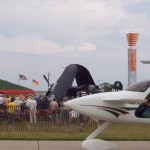
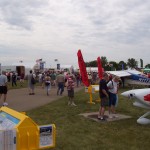
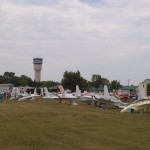
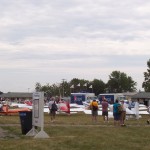
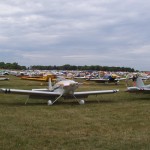
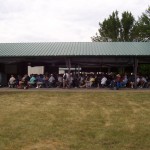
I wanted to try give some small sense of the sheer immensity of this show. These pictures show a tiny fraction of some of the acres of vendors here selling airplanes, airplane-related gadgets, memorabilia, books, antiques, and souvenirs. Additionally, you can see a few acres of aircraft…a forest of tails and propellers as far as you can see, and one of couple of dozen technical sessions (that’s probably a couple hundred folks there)!
Now, three WWI airplane replicas with special connections:
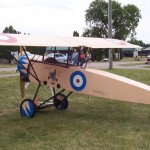
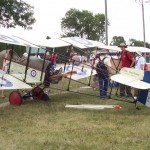
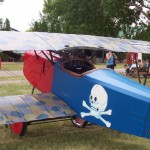
These are 3/4-scale WWI aircraft replicas. Even at 75% of the size of the original aircraft, these still can carry a pilot without a problem…just don’t expect to get where you’re going very fast! The advantage, of course, is a chance to play out all of those WWI fighter pilot fantasies.
On the left is a Morane Saulnier Type L replica, flown by Sharon Stark and built by her and her husband. I interviewed Sharon and her husband a couple of years ago. The middle aircraft is a De Havilland DH2, a pusher aircraft (having the engine and propeller behind the pilot), and then a Fokker D-VII replica.
The Morane Saulnier and the DH2 both represent different approaches to a nagging issue for early WWI fighters: how to fire a gun at the other guy. The logical approach is stick a gun right in front of you and aim your plane at them. However, it turns out that propellers and bullets don’t mix too well.
Early aviators tried a number of solutions. Most involved sticking a gun on top of the wing. Now, this was really awkward when you had to load ammunition. Imagine it: flying along at 90-100 mph, you have to unbuckle your seatbeat, stand up (!), and remove a heavy drum from the top of the gun (don’t drop anything!). Meanwhile, you still have to fly the plane, so you tuck the stick between your knees. Of course, if you need to reload your gun, it’s because you’re in a dogfight…so you’re trying to do this while some equally harassed guy is trying to shoot at you. Yeah, someone in the upper ranks really gave this one a lot of thought.
Someone else said, “Hey, let’s put the engine in the back, and the pilot will have great view forward.” Probably the best plane to follow this philosophy was the DH2 (that middle airplane, the ancestor of the De Havilland Mosquito I joked about the first evening). There were two problems with this, however. First, there was that forest of struts and wires needed to support the tail assembly. This slowed the plane down, and it was also fragile enough that it wasn’t really suited for dogfighting…one wire snaps, and everything collapses.
Then, you had that heavy engine behind you…one bad landing, and the pilot found themselves between a rock and a hard place…a rock weighing several hundred pounds and spewing gasoline all over the highly flammable nitrate dope used to seal the aircraft’s fabric covering!
It was up to the pilots on the Front Line to figure out some other options. One Russian pilot took a grapple and a length of rope up with him. When he spied a German pilot, he dropped the grapple over the side right onto the plane. Ouch. It worked…once. Another pilot managed to bring down an enemy plane simply by “flying aggressively” (the prisoner said, “That guy is crazy, I thought he was going to hit me!”).
Then, a French pilot, a former racer named Roland Garros, came up with the sort of brilliant idea of making his gun so it would fire through the propeller by bolting big angled metal plates to his propeller…the propeller of his Morane Saulnier Model L! The angle deflected the bullets to the side so they didn’t bounce back. This worked surprising well, at least as long as you weren’t standing over there on the left when Garros tested this arrangement on the ground (it was only a flesh wound).
Garros proved unstoppable for about a week. Then, one of the plates came loose and he shot his propeller into bits. When he landed, German authorities took the plane to aircraft designer and manufacturer Anthony Fokker and said, “Build us more like this.” Fokker looked at it and thought it was quite possibly the stupidest arrangement he had seen. Working with another engineer, they created a simple geared arrangement which only fired the machine guns when the propeller blade wasn’t in the way.
The Fokker planes ruled the skies for a few weeks, then everyone else figured it out. But Fokker continued to design some of the best planes of the war on either side. The D-VII (the plane on the right) was considered such a threat that this is the only type of aircraft specifically mentioned in the Treaty of Versailles.
Some other planes at random:
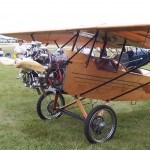
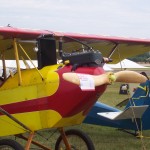
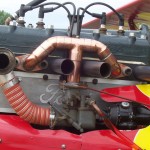
Some Pietenpols, a two-seat, high-wing (“parasol”) design originally from the 1930s utilizing a Model A four-cylinder flathead Ford engine, but adapted to all sorts of engines since then. This is a popular aircraft…the one with the round engine (a Rotec radial) was finished last year, and the yellow plane is new to the show this year. There’s at least 20 of these planes here this year!
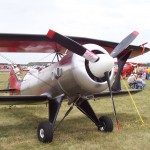
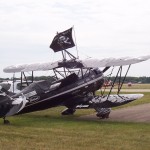
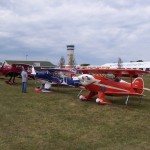
Some of the hundreds of biplanes here at the show. The piratical craft is one of the performers in the airshow.
I’m stopping here for a bit…I have to go do another interview. I’m going to see if I can set up some sort of gallery for more pictures later today. I also realized the thumbnails are linking to HUGE files, so I’ll resize these to something smaller.
Still to come from Day One: more about shooting things at propellers (it’s very cool), a Miyazaki favorite makes an appearance, and rain makes us Don’tbies…whew, this is a fair amount of work!